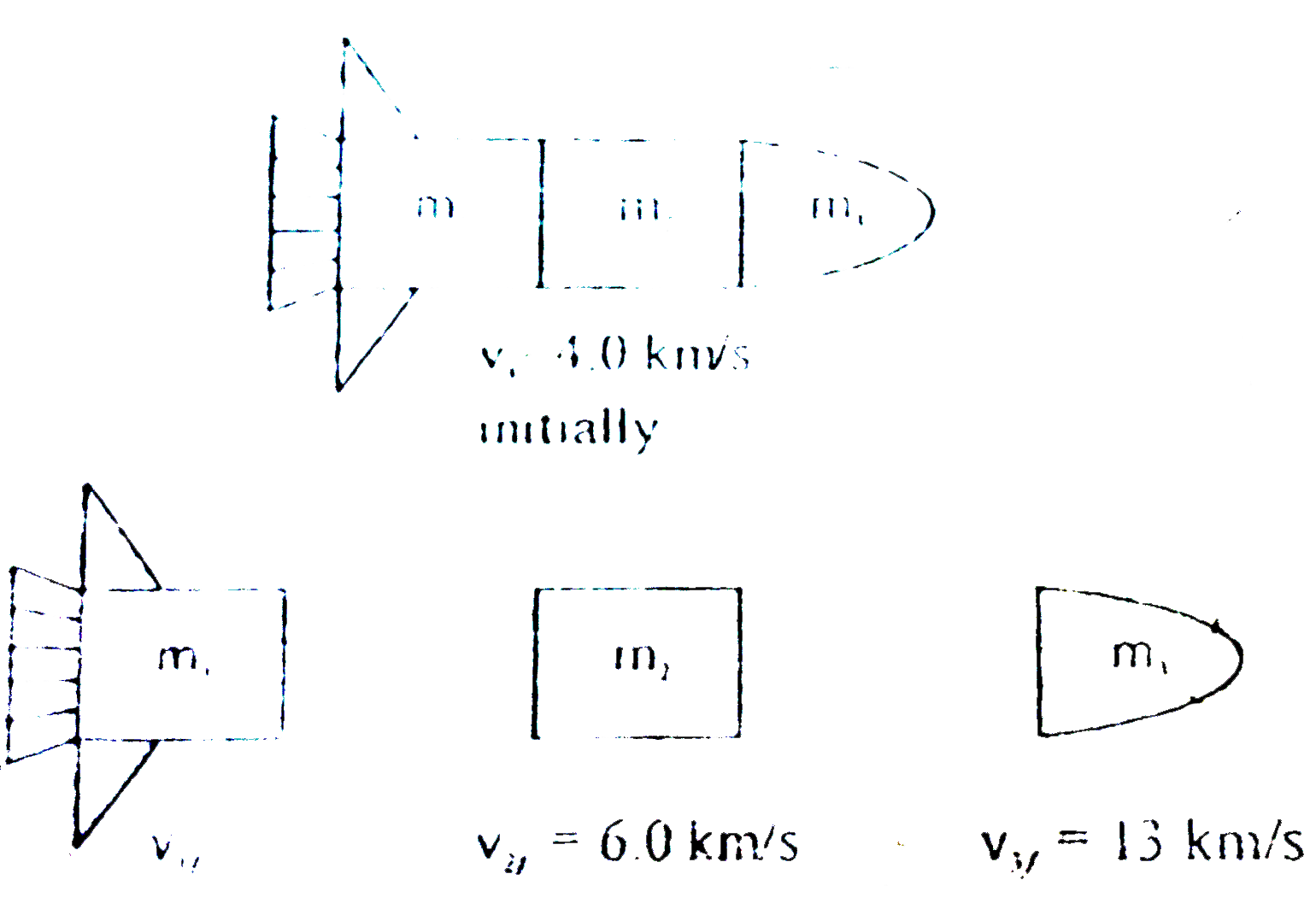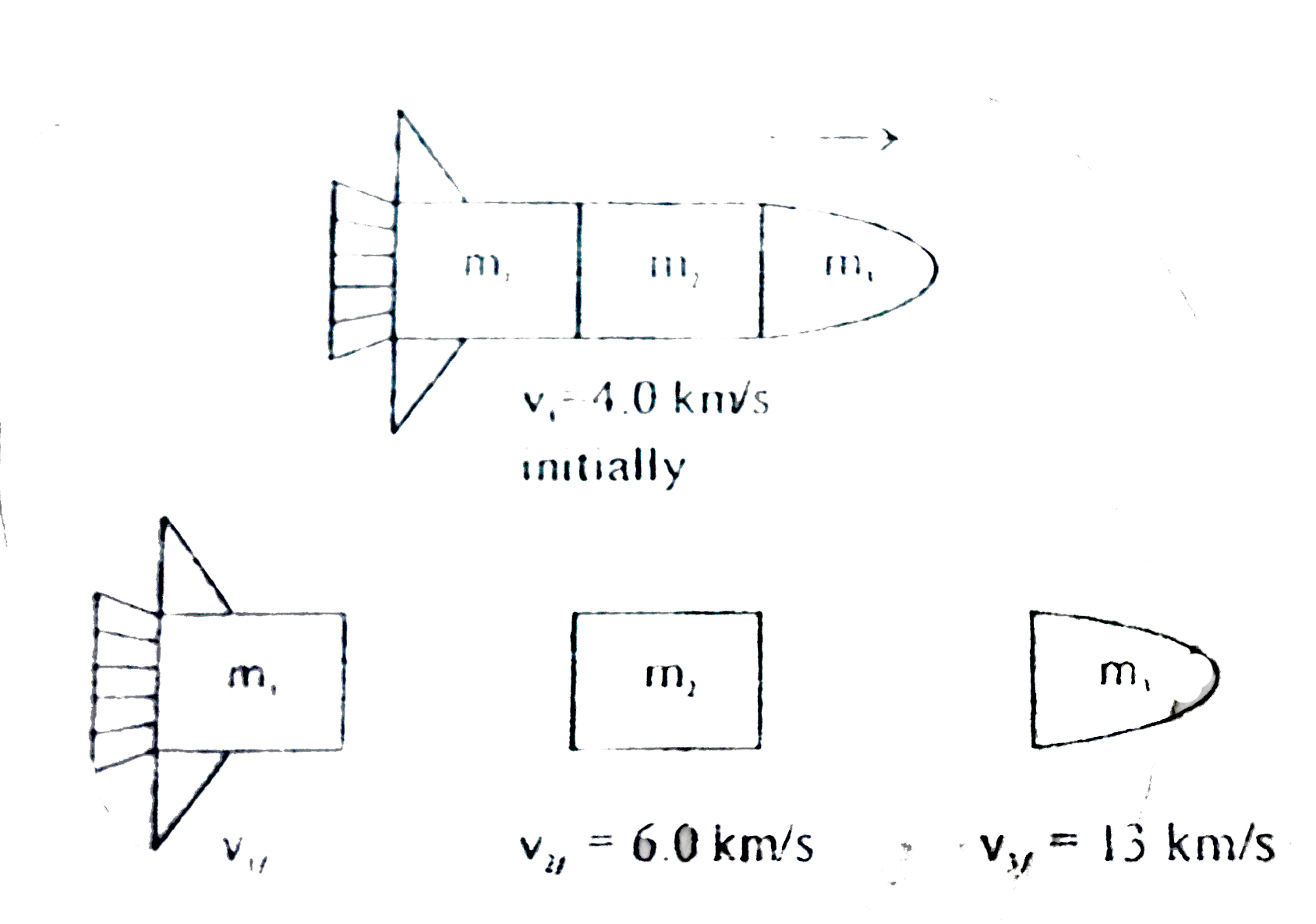A three part rocket begins intact as a single object in distant outer space, travlling to the right at 4.0km/h. The first stage (m1=950,000kg) explodes away from the rear of the rocket, with an unknown final velocity (vtf). Later, the second stage (m2=550,000kg) explodes away from teh rear with a final velocity to the right at 6.0km/s. The third stage (m2=350,000kg) ends up with a final velocity to the right of 13.0km/s. (All three move only along the x−axis . Ignore gravity. Assume that all parts of the rocket have constant masses.)

What is the final velocity (v1f) of the first stage.
919 towards left
919 towards right
917 towards left
917 towards right
The correct Answer is:A
Ans.(1)
Topper's Solved these Questions
Similar Questions
A 6090 kg space probe moving nose-first toward Jupiter at 120 m/s relative to the Sun fires its rocket engine, ejecting 70.0 kg of exhaust at a speed of 253 m/s relative to the space probe. What is the final velocity of the probe?
View SolutionA double stage rocket has an initial mass Mi, gas is exhausted front he rocket at a constant rate of dm/dt and with an exhaust velocity u relative to the rocket. When the mass of the rocket reaches the value μ, the first stage of mass m of
Which fuel is exhausted is disengaged from the rocket and then the rocket continues to the second stage at teh same rate and exhaust velocity as int eh first stage, until it reaches a mass Mf
(a). Calculate the rocket velocity at the end of the first stage, given that it is started at rest.
(b). Calculat ethe rocket velocity at the end of the second stage. ltbr> (c). What is the final velocity of a one stage rocket of the same initial Mi mass and the same amount of fuel ? it is greater or less than final velocity of the double stage rocket?View Solution
Knowledge Check
- Question 1 - Select One
A three part rocket begins intact as a single object in distant outer space, travlling to the right at 4.0km/h. The first stage (m1=950,000kg) explodes away from the rear of the rocket, with an unknown final velocity (vtf). Later, the second stage (m2=550,000kg) explodes away from teh rear with a final velocity to the right at 6.0km/s. The third stage (m2=350,000kg) ends up with a final velocity to the right of 13.0km/s. (All three move only along the x−axis . Ignore gravity. Assume that all parts of the rocket have constant masses.)

Find the impulse received by the first rocket stage.A3250000kg−km/secB4250000kg−km/secC780000kg−km/secD780000kg−km/sec - Question 2 - Select One
A 3.0-kg cart moving to the right with a speed of 1.0 m/s has a head-on collision with a 5.0-kg cart that is initially moving to the left with a speed of 2.0 m/s. After the collision, the 3.0-kg cart is moving to the left with a speed of 1.0 m/s. What is the final velocity of the 5.0-kg cart?
Azero m/sB0.80 m/s to the rightC0.80 m/s to the leftD2.0 m/s to the right - Question 3 - Select One
At the beginning of the final stage of mitosis,
AThe chromosomes that have reached their respective poles decondense .BNuclear envelope assembles around the chromosome clusters .CChromosomes cluster at opposite spindle poles and their identity is lost as discrete elements .DNucleolus , golgi complex and ER reform .
A 30 kg Sell is flying at 36m/s. When the shell explodes into two parts of 12kg and 18kg , the lighter part stops, and heavier part files on . What is the velocity of heavier part ? .
View SolutionWhat is the wavelength of an object with mass 10,000kgs that is moving with a velocity of 10,000 cm/sec?
View SolutionA 550 kg rocket sled can be accelerated at a constant rate from rest to 1650 km/h in 2.0 s. What is the magnitude of the required net force ?
View SolutionA rocket of mass 1000 kg exhausts gases at a rate of 4 kg /sec with a velocity 3000 m/s . The thrust developed on the rocket is
View SolutionA mass of 1 kg is thrown up with a velocity of 100 m/s. After 5 seconds. It explodes into two parts. One parts of mass 400 g comes down with a velocity 25 m/s Calaculate the velocity of other parts:
View Solution

